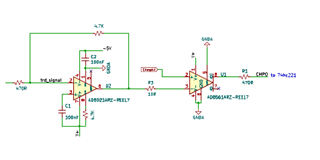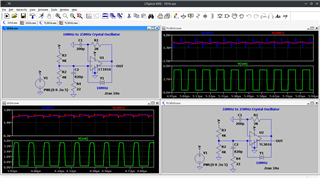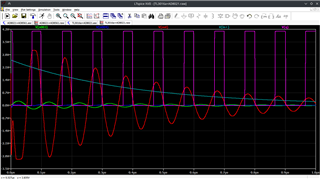- Ask a related questionWhat is a related question?A related question is a question created from another question. When the related question is created, it will be automatically linked to the original question.
This thread has been locked.
If you have a related question, please click the "Ask a related question" button in the top right corner. The newly created question will be automatically linked to this question.
Hello All,
I have attched here piece of a working circuit.I just dropped in TL3016 in place of AD8561 confident that it will replace seamlessly.
To my surprise, TL 3016 in the circuit took longer time for output. About 700 ns.
I am also attaching the LTspice simulation with TL3016 in place of LT1016. You can see the output of TL3016 and AD8561 both in the image. TL3016 shows sharper and faster repsonses in LTspice circuit for LT1016.
Can anybody here point out what connection may not be to TL3016 liking in the circuit ?


Thanks all in advance,
Parameshwar
Hi Parameshwar,
Thanks for reaching out. Can you show me the actual waveforms of your circuit, including directly measured at the inputs, outputs, and the supplies? Also, what did you mean by the output took a longer time, as in the response time or the pulse width of the output?
I also noticed the circuit on the left is a bit different from the one you simulated in ltspice. IS the one on your board the circuit on the left or right?
The circuit on board is on the left. The signal took longer time to propagate ( about 700 ns ). I did not record this measurement, I need to setup again.
In the meanwhile I setup simulation for the circuit on-board. The input signal and reference for TL3016 are about equal to what happens on the board. I am attaching the simulation results.
This circuit is identical to the left side image I posted earlier. It's results below.

As you can see, simulation results are good. ( Actually in simulation, this circuit with TL3016 works better than AD8561 ). So, TL3016 should work on board too. I want to set up one more time.
Parameshwara
We are on holiday break and will review your response once we return on Tuesday.
Chuck
OK.. In the meanwhile, I am giving you this update.
I did some more study on the real board with TL3016 in place of AD8561. In this test, I did not encounter any delayed propagation. The propagation time is about what is seen in the simulations.
Mainly I have two findings.
1. TL3016 seems to need marginally higher overdrive.
2. When signal B falls short of overdrive, Qbar output latches at HIGH state. This is what leads to ERROR ( as in my first test ). We have a counter at the 3016 Qbar output.When Qbar output latches at HIGH state and stops producing pulses, counter gets no pulses producing ERROR. I have tried enhancing the amplification around the amplifier and tested. That confirms this observation. But our application uses a standard amplification, deviation can be a commercial issue.
For observation 1, may be you can advise of ways to improve overdrive performance of 3016.
So, finally you can take this as the real question.
Rgds.
Parameshwara
Thanks again for your post. One way I can imagine you improving the prop delay which I am equating to you asking for improved overdrive performance is to actually minimize the underdrive (starting point of the waveform). Not sure if this is possible, but I am not sure what else I can suggest. And I assume using a different part with faster prop delay is not an option. Sorry, I am not sure what other advise can be offered.
Chuck
It is OK not able to suggest alternative part numbers.
Please see the attached video. Not a very well produced video.Reference signal on pin 2, signal-to-compare on pin 3(invert pin)
The top blue trace is Qbar output. Begins with latched condition. At about 13 secs you see a pulse appearing on the trace, That is when overdrive is enough. Then at about 17 secs, you will see Qbar rising and latching. This I think is not standard behaviour.
If overdrive not sufficient, Qbar should stay at LOW state. But it is switching to HIGH and latching. Mind you, pin 4,5,6 ( V-,latch,gnd) are tied together and grounded. This is an unexpected behaviour and you may be able to help me understand it.
The reason I say above behaviour is triggered at low overdrive is because if I increase pre-amplification to higher than normal, Qbar outputs pulses just like AD8561.
Not able to upload video. May be size, may be format. Below is google drive link.
Parameshwara
Thanks for your update. Unfortunately the video you linked is very blurry and its hard to tell what is going on. Could you resend so that we can see the V/DIV as well as include the inputs, outputs, and supplies?
How much overdrive is sufficient? At what overdrive does it stop latching?
You mention it begins with a latched condition but you have the latch pin tied to GND?
And how large is that pulse? Seems like its going negative.
Closing this post as we have not heard from you. Feel free to reply back if you have any updates.